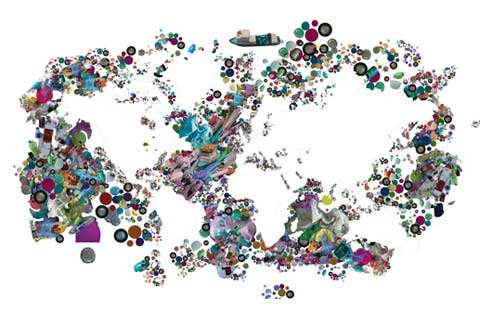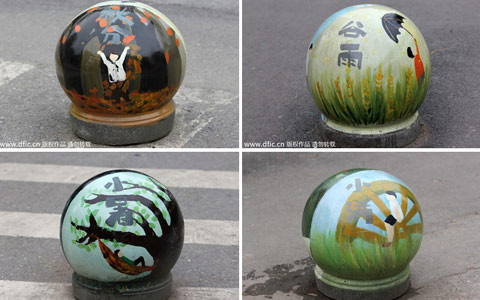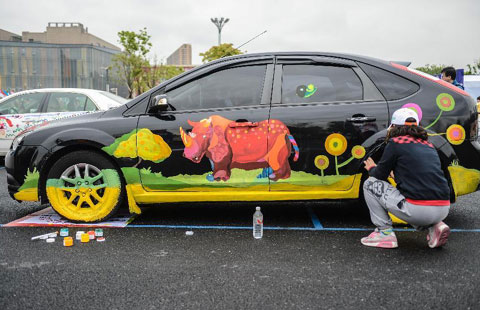Welcome to the world’s largest garbage dump
Updated: 2014-04-24 07:47
By Yang Yang (China Daily)
|
||||||||
Plastic soup
However, rather than floating trash islands, marine garbage patches are not wholly visible. Instead, the glassy calm waters are saturated with microscopic particles of degrading inorganic material that form a "plastic soup".
Like giant conveyor belts, the ocean currents can carry material vast distances. During a storm in January 1992, a ship spilled a container carrying 29,000 made-in-China plastic toy ducks into the Pacific Ocean.
Fifteen years later, a retired teacher found one of the yellow ducks as she walked her dog on a beach in Devon, southwest England. In the wake of the first toy, which had floated an estimated 17,000 miles, a further 10,000 arrived on Britain's beaches, while others headed to other destinations, including the Arctic, the US and Indonesia.
While it's estimated that as many as 10,000 containers fall off ships every year, causing shipping hazards and threatening marine life, they are not the largest sources of ocean debris.
|
80% An autopsy on a sperm whale found dead in Spanish waters found the cause of death to be ingestion of plastic. The whale’s stomach contained 24 meters of plastic. (Der Spiegel and Publico reported) 54 663 MIDWAY ISLAND IN THE NORTH PACIFIC 350,000 230,000 120,000 Of seabirds, 111 out of 312 species are known to have ingested debris. Large numbers of birds from specific species -up to 80 percent - can be affected. Plastic debris is also known to be passed to chicks in the form of regurgitated food delivered by their parents. One study estimated that fish in the intermediate depths of the northern Pacific Ocean ingest plastic at a rate of roughly 12,000-24,000 metric tons per year If plastic enters the food chain it absorbs chemical pollutants, such as DDT, from the water.The pollutants accumulate in predatory fish, such as tuna, which are in turn eaten by humans. INDIAN OCEAN GARBAGE PATCH The patch, discovered in 2010, is a gyre of marine litter suspended in the upper water column of the central Indian Ocean, specifically the Indian Ocean Gyre, one of five major oceanic gyres. Whales, dolphins, porpoises, turtles, manatees and seabirds have all been reported to have become entangled in plastic. Manatees have been found with scars or missing flippers after becoming entangled. Studies have shown that a high proportion (about 50 to 80 percent) of sea turtles found dead are known to have ingested marine debris. A photo of a dead albatross chick from the Kura Atoll, taken by the National Oceanic and Atmospheric administration in the Hawaiian Islands. THE NORTH ATLANTIC GARBAGE PATCH An area of man-made marine debris trapped in the North Atlantic Gyre. The patch is estimated to be hundreds of kilometers wide, with a density of more than 200,000 pieces of debris per square kilometer. The debris zone shifts by as much as 1,600 km north and south seasonally, and drifts even farther south during the El Niño-Southern Oscillation, according to the US National Oceanic and Atmospheric Administration. It’s impossible to measure the exact size of the patch because much of the debris floats beneath the surface of the ocean. THE GREAT PACIFIC GARBAGE PATCH A gyre of marine debris particles in the northcentral Pacific Ocean. Location: between 135W to 155W,and 35N and 42N. Characterized by: exceptionally high concentrations of pelagic plastics, chemical sludge and other debris trapped by the currents of the North Pacific Gyre. The patch, the first to be documented, was discovered in 1997 by Captain Charles Moore. Despite its size and density, it is not visible to satellites. |
"(Marine debris is) mostly land-based. Some comes from ships or fishing vessels, and some from catastrophic events, such as tsunamis, hurricanes and cyclones," said Eriksen.
"All garbage patches contain massive amounts of micro-plastics from unidentifiable origins. We can only identify micro-plastic pellets, which are oval-shaped. The large plastic items are usually fishing gear, such as buoys and lost nets. We also find plenty of bottle caps, bottles, bags, buckets, crates and other miscellaneous throwaway plastics," he wrote.
In a 2006 report called Plastic Debris in the World's Oceans, Greenpeace estimated that around 80 percent of marine trash comes from land-based sources, such as tourism- and sewage-related debris on coasts and the rest comes from ocean-based sources, such as fishing nets and lines and waste from ships and boats.
Garbage from all over the world spends one to six years reaching the Great Pacific Garbage Patch. During the voyage, the process of photo-degradation splits the plastic into smaller and smaller pieces, which float with the currents and are distributed globally.
According to the UN, of the 300 million metric tons of plastic produced globally every year, about 6 million tons end up in the oceans. Eighty percent of the waste is either washed into the sea by rivers or is carried on the wind from garbage dumps.
A long-term problem
The longevity of plastics mean the problem will be around for a long time yet. The US Environmental Protection Agency has calculated that microfilament fishing line takes 600 years to fully degrade, while plastic bottles take 450 years, and styrofoam buoys can last as long as 80 years.
In 2008, researchers from the 5 Gyres Institute trawled the Pacific patch using superfine nets, which snared plastic and plankton alike, and then weighed the results. They concluded that the density of plastic in the Pacific patch had risen to a ratio of 46-to-1 plastic to plankton by weight from 6-to-1 in 1999.
In 2010, scientists from the US-based Sea Education Association told the Ocean Sciences Meeting in Portland, Oregon, that the density of plastic debris in the Atlantic Ocean north of the Caribbean had reached 200,000 pieces per square kilometer, but that it was impossible to measure the exact size of the patch because much of the debris was floating beneath the surface.
According to the SEA, the density was such that it was comparable with the Great Pacific Garbage Patch. The association noted that the "North Atlantic Garbage Patch" has the highest concentration of plastic, most of it originating in the US, Canada, Mexico and Europe.
This plastic ocean soup poses a severe threat to marine life, and ultimately, humans. Oceanographers have discovered micro-plastics inside zooplankton, which, if consumed by fish and other creatures higher up the food chain, could eventually find their way into human stomachs. In addition, many of the micro-plastics contain poisonous materials, such as Bisphenol A, which can be released into seawater by photo-degradation.
Plastics derived from Bisphenol A have become hugely popular since they were developed in the 1950s. Their high resistance to heat and shattering, plus the great visual clarity they provide, mean they are perfect for the manufacture of items such as CDs, computers, sports equipment and food and drink containers, among other things.
However, research has indicated that BPA, as chemists know it, can affect the human endocrine system, especially during stages of rapid development, such as in fetuses or during childhood.
But even before they degrade, ocean-borne plastics have a severe effect on marine life. The UN Environment Program has reported that at least 267 marine species worldwide - including 86 percent of all sea turtles species, 44 percent of all seabird species and 43 percent of all marine mammal species - are regularly affected by becoming entangled in or ingesting marine debris.
According to Greenpeace, studies have show that about 50 to 80 percent of sea turtles discovered dead are know to have ingested marine debris, and 111 of 312 species of seabird are also known to have ingested debris.
On average, 350,000 albatross chicks hatch every year on the 6.2-sq-km Midway Island in the North Pacific. However, more than 30 percent of them die, many from malnutrition and dehydration because the parent birds mistake floating plastic debris for food.
To date, there is no effective solution to the problem. "Micro-plastics in the oceans will eventually wash ashore, UV or biodegrade, become suspended in the water column, or sink to the sea floor," Eriksen wrote.
Countermeasures
'It is a very poor use of resources to try to collect micro-plastics from the oceans. What is reasonable is to collect very large plastic pollution. This means that cleaning up beaches so that debris doesn't go back in the ocean. Also, one thing that works is to pay fishermen to recover lost fishing nets. Imagine if a fisherman was paid 1 US dollar for every 10 kilos of fishing nets they returned to land. This would prevent a net from shredding into many small particles over time," Eriksen wrote.
In the coastal city of Dalian in Northeast China's Liaoning province, Tang Zailin, deputy president of Dalian Environmental Protection Volunteers Association, organizes weekend volunteers to collect living and construction waste and litter discarded by tourists in the offshore area. The volunteer program has been running for almost 10 years.
Dalian's coastline accounts for 10 percent of China's total. Compared with the Yellow Sea, the waters of Bohai Bay are calm and gentle, and as a result, the area's self-purification capacity is relatively weak. In recent years, increased development and construction for commercial use have resulted in the rapid growth of marine garbage.
"We have been trying to collect garbage from the water, the seabed and the beaches. In general, we divide the garbage into eight major types, including construction- or tourism-related, industrial waste, and waste from marine aquaculture," Tang said.
"You can get everything that you find on land from the sea - plastic bags, newspaper, everything," he said, adding that the volunteers once fished up two cellphones from the seabed.
As a popular coastal city, Dalian's beaches are attracting an increasing number of summer tourists. Tang said 70 percent of the garbage collected on the beaches, in the water and on the seabed is plastic waste, such as food and drinks packaging, while the remainder includes cloth and rubber.
"We also count the cigarette butts we collect on the beach as plastic. They account for 10 percent of all the plastic garbage we find, and we have also found seabirds that mistook photo-degraded plastic for food and died," he said.
While the efforts of Tang and other volunteers worldwide win plaudits from all quarters, some experts, such as Carl Safina, founding president of the Blue Ocean Institute, see them as a palliative, not a solution.
Safina is convinced that problem will remain unless radical measures are undertaken on dry land, not in the oceans. For him, the type of plastic used in packaging is a crucial part of the problem.
"Plastic can be made from materials that truly degrade in sunlight and water. But now, few items are made like that. Why do we package something like yogurt, which might last two weeks, in a material that lasts centuries? It makes no sense," he said.
Contact the author at yangyangs@chinadaily.com.cn
Wang Qian contributed to this story.

 Obama roasts himself, rivals at dinner
Obama roasts himself, rivals at dinner
 Forum trends: No house, no marriage?
Forum trends: No house, no marriage?
 Huge mist cannons attract people in Lanzhou
Huge mist cannons attract people in Lanzhou
 Indian train derailment kills at least 12
Indian train derailment kills at least 12
 One handed climber scales UK's toughest routes
One handed climber scales UK's toughest routes
 World leaders when they were younger
World leaders when they were younger
 H&M promotes summer collections with DJ show
H&M promotes summer collections with DJ show
 Getting a taste for the World Cup
Getting a taste for the World Cup
Most Viewed
Editor's Picks

|

|

|

|

|

|
Today's Top News
Travel passes to DPRK made easier
Yunnan's only panda perking up thanks to TV
Intl cooperation to aid drug fight
Deal signed to upgrade roads, grid in Ethiopia
China busts foreign spy ring
Tokyo lawmakers begin China visit
Houston tries shuttlecock diplomacy
Senior Chongqing official investigated
US Weekly

|

|







